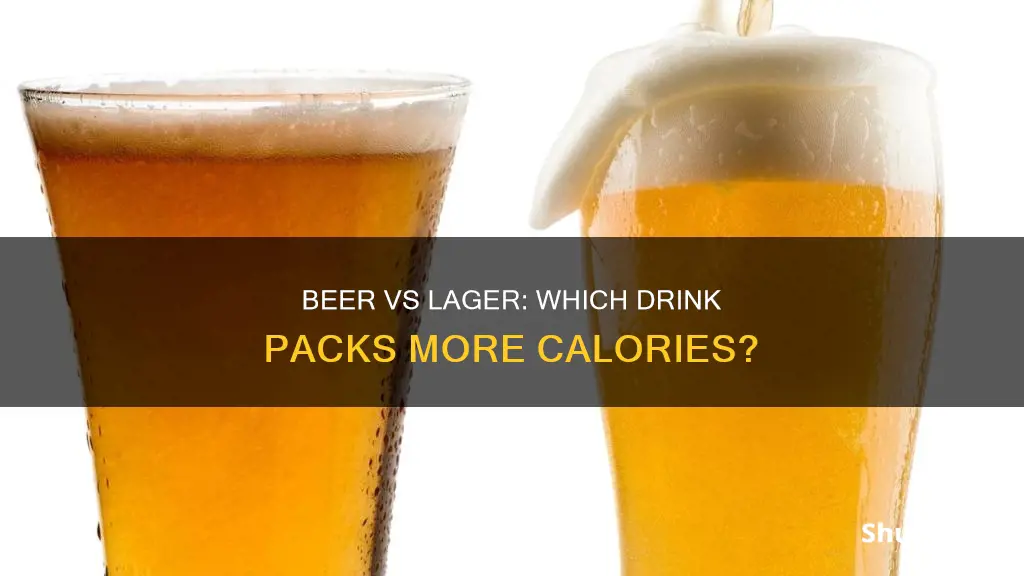
Beer and lager are both fermented grain beverages, and their calorie content depends on several factors, including alcohol content, serving size, and carbohydrate levels. While beer is known for its relatively high-calorie content, not all beers and lagers are created equal. The type of beer or lager, the brand, and the brewing process can all influence the number of calories in your drink. So, which has more calories, beer or lager? Let's explore the topic further to find out.

Alcohol content
The calorie content of beer and lager depends on several factors, including alcohol content, serving size, and type of beer or lager. Alcohol and carbohydrates are the primary sources of calories in beer and lager, with alcohol contributing about 60% of calories and the rest coming from carbs.
The higher the ABV (alcohol by volume), the more calories a beer or lager will contain. For example, a lager with 4.5% ABV at 12 oz will have approximately 135 calories, while a barrel-aged stout with 10.5% ABV at the same volume will have about 315 calories.
The average pint of beer contains around 215 calories, with the range across popular brands in the UK being 188 to 257 calories per pint. Strong lagers tend to have higher calorie content, with an average of 235 calories per pint, while mid-strength lagers have around 200 calories per pint.
Some specific examples of low-calorie beers include Coors Light (102 calories per 350ml), Bud Light (110 calories per bottle), and Corona Extra (148 calories per 350ml bottle). Non-alcoholic and low-alcohol beers also tend to have fewer calories, with some options including Lucky Saint (53 calories per bottle) and Big Drop Brewing Co.'s Citrus IPA (10 calories per can).
When comparing beer and lager, it is important to note that lager is a type of beer, and the calorie content can vary depending on the specific lager. In general, lagers tend to have fewer calories than ales or stouts, but this is not always the case, as some lagers may have similar calorie content to darker beers.
Calorie-Rich Tripel Beer: How Many Calories in One?
You may want to see also

Carbohydrates
The amount of carbohydrates in beer varies depending on the type. Lagers, for example, tend to contain fewer carbs than ales, and ales have fewer carbs than stouts. However, this is not always the case, as some lagers may contain as many calories as a dark beer.
The sugar extracted from barley and grains is what causes beer to ferment, and the more sugar present, the more alcohol is produced, resulting in more calories. Therefore, the higher the ABV (alcohol by volume), the more calories in the beer. For instance, a lager with 4.5% ABV and 12 oz. will have 135 calories, while a barrel-aged stout with 10.5% ABV and 12 oz. will have 315 calories.
When it comes to calories, lager tends to have fewer calories than other beer types. A pint of mid-strength lager, typically around 4.5% ABV, contains approximately 200 calories, while stronger lagers usually have around 235 calories in a pint glass. However, there are low-calorie lager options available, such as Corona Extra, which has 148 calories per 350ml bottle, and Skinny Brands Lager, which has 87 calories per bottle.
Calorie Counting: Bud Select Beer's Nutritional Breakdown
You may want to see also

Calorie calculation
The number of calories in beer depends on several factors, including the serving size, type of beer, and alcohol content. Beer is made from fermented grain, and the calories come primarily from alcohol and carbohydrates. A gram of alcohol contains seven calories, almost as many as a gram of pure fat.
Factors Affecting Calorie Content
The type of beer plays a significant role in determining its calorie content. For example, lagers tend to have fewer carbohydrates and calories compared to ales, and stouts generally have the highest carb content. However, some lagers may contain as many calories as a dark beer. Additionally, craft, seasonal beers, and beers with higher alcohol content tend to be more calorie-dense than lighter options.
The serving size also matters. A typical pint of beer contains around 215 calories, but this can vary across brands and styles. For instance, the calorie content of the 10 most popular beers in the UK ranges from 188 to 257 calories per pint.
Calculating Calories
To calculate the number of calories in a beer, you can use the following formula:
Calories = (ABV% x 2.5) x fl oz
Here, ABV% refers to the percentage of alcohol in the beer (alcohol by volume), and fl oz is the volume in fluid ounces. For a pint of beer (20 fluid ounces) with an ABV of 4%, the calculation would be:
Calories = (4% x 2.5) x 20 fl oz = 200 calories
Low-Calorie Options
If you're looking for low-calorie options, non-alcoholic beers are a good choice as they usually contain fewer calories. For example, Big Drop Brewing Co.'s Citrus IPA has only 10 calories per can, while Days Brewing Lager has 73 calories per 350ml bottle. Among alcoholic beers, Skinny Brands Lager has 87 calories per bottle, and Coors Light has 102 calories per 350ml serving.
Cherry Wheat Beer: Calorie Count and Nutrition Facts
You may want to see also

Weight gain
Beer and lager are both high in calories, which can contribute to weight gain if consumed in excess. Alcohol is highly calorific, with a gram of alcohol containing seven calories—almost as many as a gram of pure fat. The sugar extracted from barley and grains during the fermentation process results in a higher alcohol content and, consequently, more calories.
The calories in beer primarily come from two sources: alcohol and carbohydrates. According to the Homebrewer's Association, about 60% of beer calories originate from alcohol, while the rest are derived from residual carbs that were not fully fermented during brewing. Different types of beer contain varying amounts of carbohydrates. For example, lagers generally have fewer carbs than ales, and ales have lower carb levels than stouts. However, this is not always the case, as some lagers may contain similar calories to a dark beer.
The strength of a beer is closely linked to its calorie content. A lager with 4.5% ABV in a 12 oz serving will amount to 135 calories, whereas a barrel-aged stout with 10.5% ABV in the same serving size will total 315 calories. Similarly, a standard glass of wine can have up to 158 calories, and certain strong lagers can contain up to 222 calories per pint.
Consuming three pints of standard-strength beer in a night can easily add up to 600 calories. If this becomes a regular occurrence, it can lead to weight gain over time, especially without regular exercise. For instance, drinking five pints of 5.2% strength lager each week results in an annual calorie intake of 57,720 calories.
To put this into perspective, a typical 12 oz beer has as many calories as a can of Coke (approximately 140 calories). Some beers have twice that amount, and when served in larger glasses, such as 16 or 20 oz, the calorie count can reach 200 to 250 calories.
While beer and lager can contribute to weight gain, it is important to note that occasional consumption will not make one overweight. However, regularly consuming more calories than one expends can lead to weight gain and potential health issues.
Sierra Nevada Torpedo Beer: Calorie Count and Nutrition Facts
You may want to see also

Low-calorie beer
Beer is a popular alcoholic drink made from fermented grain. While it's a tasty treat, it can be high in calories, with a typical 12 oz beer containing around 140 calories—the same as a can of Coke!
If you're watching your weight, you might want to consider switching to a low-calorie beer. These beers have diversified in recent years, and there are now many delicious options that don't pack too many calories.
How to Choose a Low-Calorie Beer
- Alcohol Content: Since alcohol provides around seven calories per gram, the lower the alcohol content, the fewer calories the beer will contain.
- Taste: Sweeter-tasting beers tend to have more calories.
- Light vs Dark: Contrary to popular belief, the colour of the beer doesn't determine its calorie content. Dark beers can be surprisingly light in calories!
Recommended Low-Calorie Beers
- Lagers: Budweiser Select, Molson Ultra, Sleeman Light, Miller Light, Heineken Light, Corona Light, Coors Light, Brava Light, and Samuel Adams.
- Ales: Le Petit Prince, Dogfish Head Slighty Mighty, Lagunitas DayTime, Lakefront Eazy Teazy, Kona Kanaha Blonde Ale, and Firestone Walker Easy Jack.
- Stouts: Guinness Extra, Young's Double Chocolate Stout, and Murphy's Irish Stout.
- Gluten-Free: Glutenberg Blonde, Holidaily Favorite Blonde, and Coors Peak.
- Non-Alcoholic: Coors Edge, Beck's Non-Alcoholic Beer, Heineken 0.0, Bavaria 0.0% Beer, and Budweiser Prohibition Brew.
Tips for Drinking Beer While Watching Your Weight
- Alternate with Water: Drinking a glass of water between alcoholic beverages can help prevent dehydration and slow down your drinking.
- Pace Yourself: Take small sips and drink at your own pace to avoid binge drinking, which can lead to weight gain.
- Eat First: Drinking with a meal or after a healthy dinner can help you make better food choices throughout the night.
- Avoid Drinking on an Empty Stomach: If you do get hungry, opt for healthier snacks.
- Drink in Moderation: Stick to the recommended limit of two drinks per day for men and one drink per day for women.
Beer or Wine: Which Has Fewer Calories?
You may want to see also
Frequently asked questions
It depends on the type of beer and the lager in question. However, generally, lager contains fewer calories than other beer types.
The calorie content of beer depends on the serving size, the alcohol content, and the type of beer.
The formula for calculating the calories in a beer is: Calories = (ABV% x 2.5) x fl oz.
On average, a typical pint of beer contains around 215 calories. The exact amount varies across brands and styles, but across the 10 most popular beers in the UK, it ranges from 188 to 257 calories per pint.
Some examples of low-calorie beers include Coors Light (102 calories), Bud Light (110 calories), Corona Extra (148 calories), and Skinny Brands Lager (87 calories).







